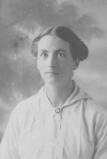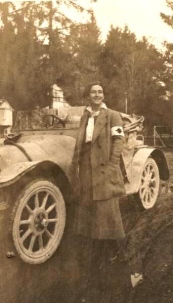We’re pleased to present a guest blog post from Emma Hancox, who recently spent two weeks at the Library as part of her archives and records management training.
As a student on the M.A. course in Archives and Records Management at University College London, I was fortunate to have the opportunity of a two week cataloguing placement at the Library of the Society of Friends. I had expressed a wish for a placement there because I knew that the Quakers had a reputation for being heavily involved in social justice, a subject in which I am particularly interested, and felt that the archives would be a rich record of this work. The collection I was given to catalogue did not disappoint. The personal papers of Hilda Clark (1881-1955), humanitarian aid worker and physician, brought to life Quaker relief work in war-torn Europe during and after World War I.

Hilda Clark (1881-1955)
(Lib. Ref. TEMP MSS 301/PH/1)
Hilda Clark, daughter of the well-known shoe manufacturer, William Stephens Clark (1839-1925), of Street, Somerset, trained as a physician in 1901. Her papers are a testament to her dedication to helping those in desperate need because of war and social and political turmoil. At the outbreak of World War I in 1914 Hilda Clark and others presented a concern to Meeting for Sufferings (the Society of Friends’ representative committee) that the Society of Friends should provide relief to French refugees. Having gained support she left for France on 5 November 1915 with a group of pacifist workers, mainly Quakers.

Hilda Clark (1881-1955), wearing the Quaker star armband. ca. 1915
(Lib. Ref. PIC 89/A 217)
Letters to her close lifelong friend, Edith M. Pye (1875-1965), and sister, Alice Clark (1874-1934), provide moving accounts of conditions in the maternity hospital in Châlons-sur-Marne (now Châlons-en-Champagne) that Hilda helped to establish and later supervise. The papers also describe life in the convalescent home which she helped to set up for refugees in Samoëns in Haute Savoie, and her work with refugees in Paris.
The archive includes a photograph, mounted and signed by the team at the hospital, to be presented to Hilda Clark. Alongside the team, it shows a group of mothers proudly holding their new-born babies: it conveys the loving and attentive atmosphere created by Hilda Clark in an area torn apart by war. Postcards, also in this collection, show the aftermath of bombardments in Reims and evidence of the extent of the destruction in France.

Photograph of ward scene, Châlons-sur-Marne Maternity Hospital, ca. 1915. Signed by colleagues on the reverse, “With love from the Chalons equipe to Dr. Clark”
(Lib. Ref. TEMP MSS 301/PH/1)
Once the War was over Hilda Clark’s attentions turned to Austria and specifically to those affected by the blockade induced famine there. She spent time in Vienna administering aid and reported on conditions to the Friends War Victims Relief Committee. This period in her life is covered by correspondence to friends and family and through her collection of reports on Austria, which form part of the collection.
Hilda Clark’s involvement in the League of Nations, the Women’s Peace Crusade, and the Women’s International League for Peace and Freedom as well as her numerous fact-finding visits to countries such as Greece are also reflected in her papers, her peace work through letters, and her visit to Greece in 1923 through lantern slides which accompanied her talks. In the 1930s, Hilda Clark worked as a public speaker and broadcaster on international issues. She worked for the relief of child refugees from the Spanish Civil War and aided refugees from Nazi Germany and from Austria. In 1940, when her home in London was bombed, she moved to Kent. In 1952 she returned to Street, where she died on 24 February 1955.
The papers of Hilda Clark (TEMP MSS 301) provide an insight into a remarkable woman who gave up her own safety and comfort in order to help those affected by war, famine and racial discrimination: something we can all admire and learn from today.

Reblogged this on Special Collections at the University of Bradford and commented:
An archive which overlaps with many of those at Bradford!
are all the materials in the Friend’s Library in London?
Yes, the Hilda Clark material catalogued by Emma is all held at the Library here in Friends House, London. The reference for the collection is Temp MSS 301. Later this year, when our new online catalogue is launched, you will be able to see full details of the collection online. Meanwhile, if you want to find out more please contact the Library through the link to the right.
I am trying to assist a fellow Wikipedian to get an article about Hilda Clark accepted. See https://en.wikipedia.org/wiki/Dr_Hilda_Clark. Are there any free to use photographs of Hilda we can use?
Pingback: Quaker feeding programmes in postwar Germany and Austria | Quaker Strongrooms
Pingback: Women’s History Month | Quaker Strongrooms